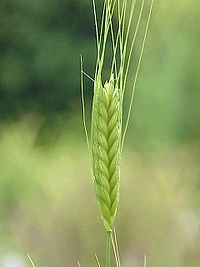
Photo from wikipedia
Our objective was to assess the relationship between wheat flour analytical values and baked good properties based on equipment and processes near to those of mid-size bakery companies, including fermentation… Click to show full abstract
Our objective was to assess the relationship between wheat flour analytical values and baked good properties based on equipment and processes near to those of mid-size bakery companies, including fermentation interruption. Thirty-four physical properties of rolls and breads were measured, and their correlation with 90 analytical properties of flour was investigated. In rolls, fermentation interruption led to a coarser crumb structure and a lower height/width ratio as compared to direct fermentation. This can be seen as a quality loss, which extent varied considerably depending on the flour. Our results suggest that using flours with a strong gluten network and high water absorption properties are most appropriate for fermentation interruption. Using a PLS regression, we identified three flour properties that had the highest overall influence on the final baked goods properties: flour hydration, dough stability, and elasticity/plasticity ratio.
Journal Title: European Food Research and Technology
Year Published: 2017
Link to full text (if available)
Share on Social Media: Sign Up to like & get
recommendations!